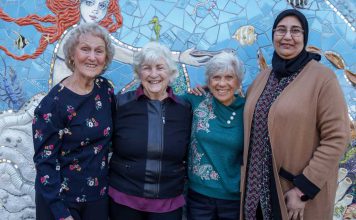Gilroy is becoming increasingly Latino, according to new census reports, and its elected officials match the city’s shifting demographics.
The re-election of Peter Leroe-Muñoz as the Gilroy City Council’s fourth Latino member may enable the city to avoid the kind of dramatic shift to district elections that is roiling local politics in cities and special districts throughout the state.
A change in the state’s Voting Rights Act in 2017 made it easier for a single individual to force district representation if the composition of elected councils and boards doesn’t represent a community’s ethnic diversity.
Gilroy Mayor Roland Velasco, Gilroy’s first Latino mayor, is both proud of and relieved by the strong Latino presence on the council.
“The city is well represented by individuals who bring a diverse background, education and qualifications,” the mayor said in an interview this week. “Gilroy has four Latino representatives on the council plus a Latino city administrator.”
The American Community Survey released this fall by the U.S. Census Bureau pegged GIlroy’s annual population growth at more than 4 percent in 2017, the highest rate in years, and the percentage of Latino Gilroyans passed 60 percent for the first time. The city’s 2018 estimated population is 57,644, with 60.6 percent identifying as Hispanic/Latino, according to the census survey.
The city council’s four Latino members—Velasco, Leroe-Muñoz, Fred Tovar and Cat Tucker—represent 57 percent of the council, whose members are elected on a citywide vote.
“The state Legislature has created a presumption that cities should elect their councils by district,” said Don Larkin, city attorney for Morgan Hill. His city, which is one-third Latino, elected it first Latina city council member in years in November, when it switched to district elections.
When one citizen threatened a lawsuit in Morgan Hill in 2017, the council, on Larkin’s advice, made the switch. He said contesting the challenge would have been “an uphill battle.”
“The risks are very high if you fight the change and lose.”
The state Voting Rights Act of 2001 prohibits “the use of an at-large election…if it would impair the ability of a protected class…to elect candidates of its choice.” This prompted an increasing number of California cities and school to switch to district representation, often in response to lawsuits or complaints from one of the ethnic designations cited in the law—Latinos, African-Americans or Asian-Americans.
The city of Morgan Hill isn’t the only elected body to change the way its members are elected. Morgan Hill schools switched to district voting in 2015. Gilroy’s Gavilan College switched to district voting in 2016. To the south, the San Benito High School district held its first district elections this fall. The City of Hollister—about 67 percent Latino—has been electing its council members by districts since 1994, seven years before the California Voting Rights Act.
Other demographic factors that represent political diversity, such as gender or household income or geography, aren’t valid reasons for challenging at-large voting under the Voting Rights Act, said Robert Rubin, a San Francisco lawyer considered an expert on the law.
Other factors may be valid political arguments for switching to district voting, but not legal ones, he said.
Three Gilroy City Council members are women, two newly elected in November.
The Gilroy election, while retaining a Latino majority on the council, also reflected a consolidation of political power in a handful of affluent neighborhoods where Latinos account for less than one-third of the residents.
Velasco, Leroe-Muñoz, Tucker and Marie Blankley live in a two-square mile area in the northwest quadrant of the city. According to the U.S. Census, these are among the most affluent neighborhoods in Gilroy.
Velasco, Blankley and Tucker live in one census tract west of Santa Teresa Boulevard and north of Hecker Pass Road where the median household income is $137,635 and the Latino population 32 percent. That’s nearly 59 percent above the $86,742 median household income for the city as a whole.
Two council members, Tovar and Carol Marques, live in adjoining neighborhoods just west of downtown, east of Wren Avenue between Third and 10th streets, where the median household income is $72,727, slightly lower than the city as a whole. Councilmember Dion Bracco lives east of US 101, where the median household income exceeds the citywide median, at $100,875.
Sandwiched in between these two moderate-income neighborhoods are the areas around Monterey Street, the center of downtown Gilroy just west of US 101. This long strip of commercial and residential properties straddles the Union Pacific Railroad tracks and divides the city like a zipper. It has Gilroy’s highest population densities, its lowest incomes and the highest percentages of Hispanic/Latino Gilroyans, above 80 percent.
The median household income in this central strip is $48,125. Household incomes in some neighborhoods west of Santa Teresa, just two miles west of Monterey Street, are nearly triple the center city households.
In a city where all council members are elected by and represent the city as a whole, identity politics—whether by ethnicity, race, language or gender—have not come into play in local elections, either publicly or privately.
Broad topics like development and growth tended to dominate local political debates in Gilroy, and slow-growth advocates—the mayor is one—are gaining influence. This is happening against a backdrop of a city that for 20 years has added nearly 1,000 residents per year.
No council members live in the three census tracts in Gilroy’s central corridor, home to approximately 15,000 people—mostly Latino, with lower incomes.
Velasco said it is important to monitor demographic shifts. A change in the state voting rights law in 2017 said potential plaintiffs seeking a change to district voting need only to send one letter to initiate the process.
“This is an important issue that we will continue to monitor, but it’s not necessary to overreact to bring a district election solution to a problem that doesn’t currently exist,” he said. “Other jurisdictions were out of balance.”
“The bar is really low,” cautioned Morgan Hill’s Larkin. “In order to demonstrate that a city should use district elections, a plaintiff does not have to show any history of discrimination or that it is intentional,” Larkin said. “They don’t even have to show it would make a difference in getting a minority voter elected.”














